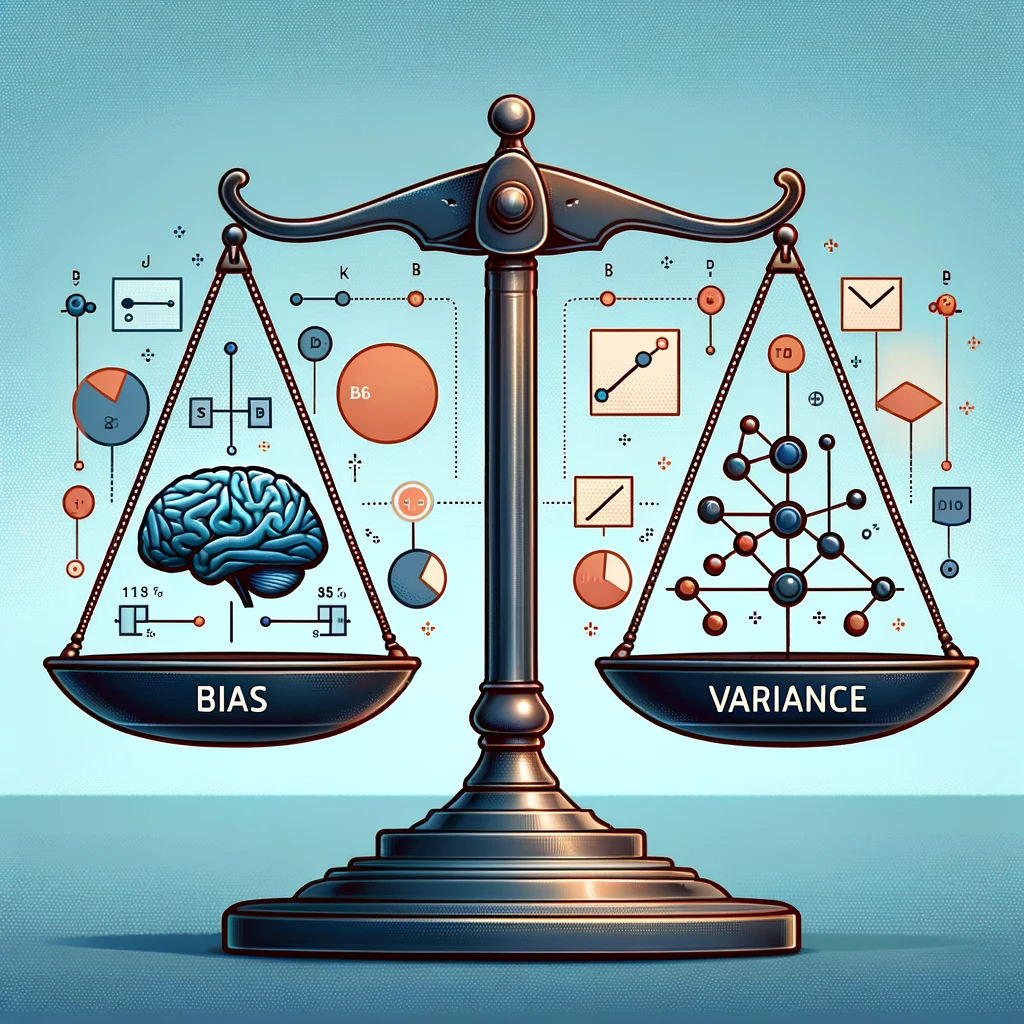Bias-Variance Tradeoff in Machine Learning
 Juan Carlos Olamendy
Juan Carlos Olamendy
Have you ever wondered why some machine learning models excel in theory but fail in real-world applications?
Have you faced this challenge before?
Don't worry. I really understand.
Enter the Bias-Variance Tradeoff, a cornerstone concept in machine learning that dictates the success of models in real-world scenarios.
This article delves deep into this critical topic, shedding light on its intricacies and practical implications for model development.
And remember, If you like this article, share it with others ♻️ . Feel free to follow me for articles more like this.
Introduction
Imagine a tightrope walker balancing high above - this is akin to managing the Bias-Variance Tradeoff in machine learning models.
Just as the tightrope walker must maintain a perfect balance to avoid falling, machine learning models must strike a balance between bias and variance to achieve optimal performance.
Assumptions and Flexibility
Low-bias models, unlike their high-bias counterparts, do not presume a specific pattern in data.
They learn complex data patterns, making them versatile yet complex.
In contrast, high-bias models are simpler, for example, assumes linear relationships; and often overlooking intricate data patterns.
The Dilemma of Overfitting and Underfitting
Low-bias models are adept at uncovering complex data relationships.
However, their sophistication can lead to overfitting, where they perform exceptionally on training data but poorly on new, unseen data.
High-bias models, in their simplicity, risk underfitting, failing to capture crucial trends in the data.
The Art of Generalization
Generalization is the ultimate goal in machine learning.
Low-bias models aim to perform well not only on training data but also on new, unseen data.
This requires a delicate balance to prevent overfitting, ensuring the model's broad applicability.
Sensitivity to Training Data
Machine learning models vary in their reaction to changes in training data, a critical aspect in model performance.
The Steady Hand of Low Variance Models
Low variance models offer consistent results, regardless of training data variations.
They are predictable but may oversimplify the problem, leading to underfitting.
The Chameleonic Nature of High Variance Models
High variance models are adaptable, capturing nuanced data patterns and random noise as well.
Their flexibility can be a double-edged sword, making them prone to overfitting and inconsistent performance across different datasets.
Model Selection
The Bias-Variance Tradeoff is at the heart of model selection in supervised learning, influencing the accuracy and applicability of models.
Bias: The Simplification Challenge
High bias results from oversimplifying complex real-world problems, leading to systematic prediction errors.
Variance: The Complexity Conundrum
High variance arises from a model's sensitivity to training data, often capturing noise as if it were a significant pattern.
Tackling the Bias-Variance Tradeoff
Navigating the Bias-Variance Tradeoff involves employing strategies that optimize a model's ability to generalize from training data to unseen data.
Here's a closer look at how to address this fundamental challenge in machine learning.
The Inevitable Tradeoff: A Delicate Balance
No Perfect Solution: The pursuit of minimizing bias and variance is a balancing act, as reducing one often increases the other.
Complexity and Its Effects: A complex model may decrease bias but increase variance, and vice versa.
Techniques to Bridge the Gap
Regularization and Pruning: These techniques help control high variance in complex models, aiding in the prevention of overfitting.
Cross-Validation: This method assesses a model's variance, offering insights into its performance on new data.
Ensemble Methods: Combining models, like in Random Forests, helps leverage their strengths while mitigating individual weaknesses.
Data Requirements: High variance models generally require more data to train effectively, as they can otherwise overfit to limited or noisy training data.
Linear and Logistic Regression: High Bias, Low Variance
Linear and logistic regression models exemplify high bias and low variance, ideal for scenarios where data relationships are predominantly linear.
Simplicity and Predictability
Linear Assumptions: These models assume linear relationships, simplifying complex real-world data.
Consistency Across Datasets: Their simplicity yields consistent performance but may lead to underfitting in complex scenarios.
Degrees of Freedom in Linear Models
N >> M Regime: When data points exceed features, linear models perform adequately, fitting parameters effectively.
High Bias, Low Variance: Due to strong assumptions, they exhibit high bias and low variance.
Addressing Overfitting in High-Dimensionality
- L1 Regularization: This technique helps in high-dimensional scenarios, promoting sparsity and feature selection.
The Power of Ensembles: Low Bias, High Variance
Ensemble models like Random Forests and XGBoost demonstrate the capacity to capture complex data patterns due to their low bias and high variance nature.
Decision Trees and Random Forests
Decision Trees: Highly flexible but prone to overfitting and high variance.
Random Forests: By averaging multiple trees, they achieve lower variance, enhancing generalizability.
XGBoost: A Robust Ensemble Approach
Regularization: Integrating regularization directly into tree learning, XGBoost effectively manages overfitting.
Boosting vs. Random Forest: XGBoost's sequential error correction offers adaptability and efficiency, especially in large datasets.
Neural Networks: The Bias-Variance Spectrum in Deep Learning
Neural networks, especially deep ones, embody a unique position in the bias-variance spectrum, capable of modeling highly complex functions.
The Flexibility of Neural Networks
Low Bias: Their flexibility allows them to capture a wide array of complex relationships, resulting in low bias.
Universal Approximation: Given sufficient depth and neurons, neural networks can approximate almost any function, revealing intricate patterns in data.
Managing Variance in Neural Networks
High Variance and Overfitting: Their complexity and learning capacity can lead to high variance, evident in overfitting issues.
Regularization Techniques: L1/L2 regularization, dropout, and early stopping are crucial for controlling overfitting.
Data Requirements: To effectively reduce variance, neural networks often require extensive datasets.
Architectural Considerations
- Balanced Design: The architecture of the network, including the number of layers and neurons, must be carefully calibrated to avoid over-complexity, which increases variance, or oversimplification, leading to high bias.
Emphasizing Generalization
Batch Normalization: This technique can aid in stabilizing learning and reducing both bias and variance.
Prioritizing Generalization: The focus should be on how well the model performs on unseen data, finding an optimal point in the bias-variance tradeoff.
Conclusion
The Bias-Variance Tradeoff is a fundamental challenge in machine learning.
By carefully considering model complexity, employing regularization and pruning techniques, leveraging ensemble methods, and prioritizing generalization, you can navigate this tradeoff effectively.
Embarking on this journey requires patience, skill, and a deep appreciation of the intricacies of machine learning models.
The Bias-Variance Tradeoff is not just a theoretical concept but a practical guide that illuminates the path to creating effective, reliable, and robust machine learning models.
As the field evolves, so will our approaches to this tradeoff, continuously pushing the boundaries of what is possible in the realm of machine learning and artificial intelligence.
If you like this article, share it with others ♻️
Would help a lot ❤️
And feel free to follow me for articles more like this.
Subscribe to my newsletter
Read articles from Juan Carlos Olamendy directly inside your inbox. Subscribe to the newsletter, and don't miss out.
Written by

Juan Carlos Olamendy
Juan Carlos Olamendy
🤖 Talk about AI/ML · AI-preneur 🛠️ Build AI tools 🚀 Share my journey 𓀙 🔗 http://pixela.io